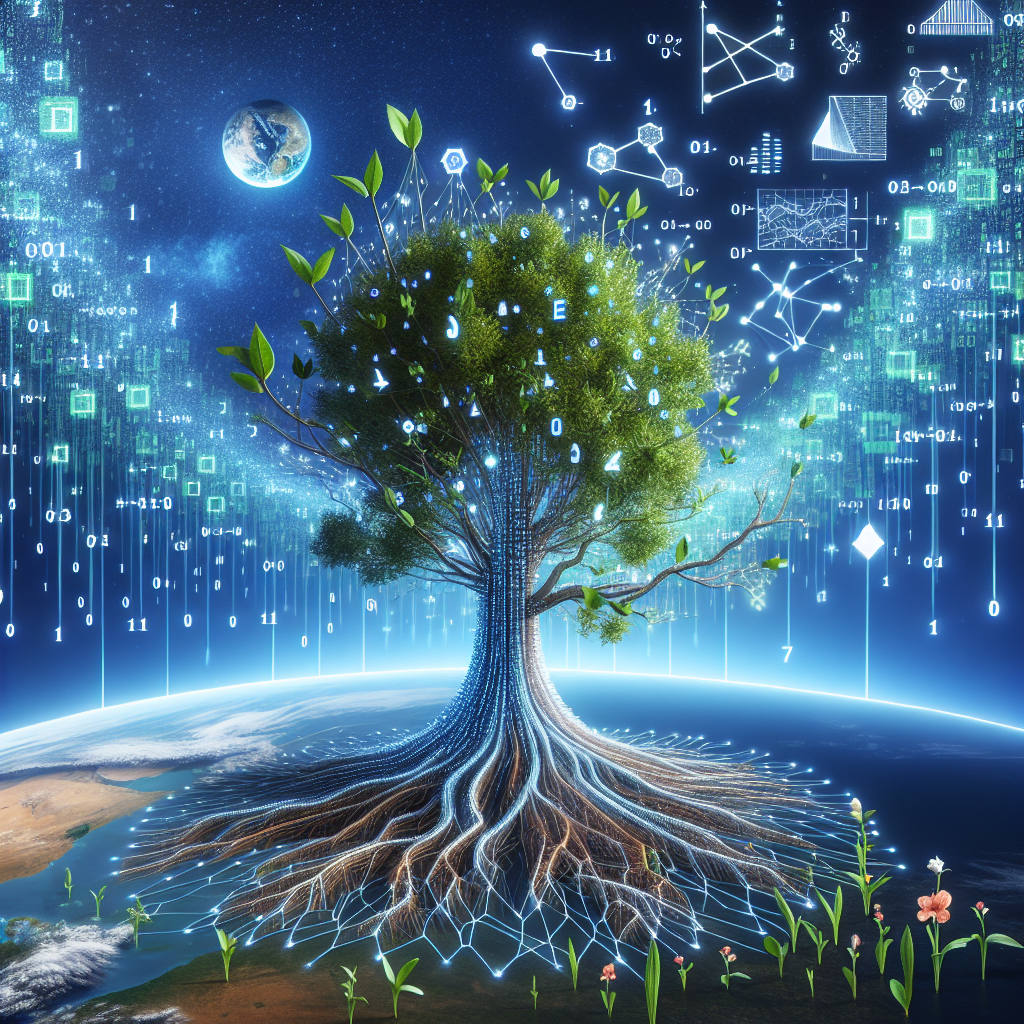Imagine a world where technology is not just a part of our daily lives, but also a key player in combating one of the greatest challenges of our time – climate change. Artificial Intelligence, or AI, is no longer just a concept confined to science fiction; it has become a powerful tool that is revolutionizing various industries. In this article, we will explore how AI is making a significant impact in the fight against climate change and how it is shaping the way we approach sustainability. Brace yourself for a glimpse into the incredible ways AI is transforming our planet and our future.
Monitoring and predicting climate patterns
Enhancing climate modeling
Artificial Intelligence (AI) is revolutionizing the way climate patterns are monitored and predicted. By using advanced machine learning algorithms, AI systems can analyze vast amounts of data from various sources such as satellites, weather stations, and ocean buoys. This allows scientists and researchers to gain a more comprehensive understanding of climate patterns and their underlying causes. AI can also identify complex relationships and patterns that humans may overlook, leading to more accurate climate models.
Improving weather forecasting
Thanks to AI, weather forecasting has become more accurate and reliable. AI algorithms can process large datasets and consider a wide range of factors, including atmospheric conditions, historical weather data, and global climate patterns. By analyzing this information, AI systems can predict weather patterns with greater precision and provide more timely and localized forecasts. This enables communities to take proactive measures to protect themselves against severe weather events and reduce the loss of life and property.
Detecting climate trends
AI technology plays a crucial role in detecting climate trends and understanding long-term changes in our environment. By analyzing historical climate data, AI systems can identify patterns and trends that may indicate climate change. This allows scientists and policymakers to make informed decisions regarding climate mitigation and adaptation strategies. AI can help identify areas that are particularly vulnerable to climate change, allowing for targeted solutions to be developed.
Environmental conservation and sustainability
Optimizing energy consumption
AI is revolutionizing the way we conserve energy by optimizing energy consumption. Smart algorithms can analyze energy usage patterns in buildings, factories, and transportation systems. By identifying areas of inefficiency, AI systems can recommend energy-saving measures, such as optimizing heating and cooling systems, implementing smart grids, and reducing energy wastage. This not only reduces energy consumption but also lowers greenhouse gas emissions and promotes sustainability.
Managing water resources
AI is also used to manage and conserve water resources effectively. By analyzing data from sensors and satellites, AI systems can monitor water sources, detect and predict droughts, and optimize water allocation. AI-powered irrigation systems can adjust watering schedules based on weather conditions and individual plant needs, reducing water waste in agriculture. This technology can help ensure the sustainable use of water resources, especially in areas prone to water scarcity.
Mitigating air pollution
AI has the potential to significantly reduce air pollution levels through various applications. AI systems can analyze air quality data from sensors and satellites to identify pollution hotspots and sources. This allows policymakers to implement targeted solutions, such as reducing emissions from specific industries or improving urban planning to reduce traffic congestion. Additionally, AI can optimize traffic management systems to minimize fuel consumption and emissions, contributing to cleaner and healthier air quality.

Evaluating climate risks and vulnerabilities
Assessing impact on ecosystems
AI technology enables the assessment of the impact of climate change on ecosystems. By analyzing data on temperature, precipitation, vegetation, and biodiversity, AI systems can provide insights into how ecosystems are responding to environmental changes. This information helps scientists and conservationists understand the vulnerabilities of different ecosystems and develop strategies to protect biodiversity and promote ecosystem resilience.
Identifying at-risk areas
AI algorithms can analyze various data sources to identify areas at risk from climate-related events such as floods, wildfires, and storms. By considering factors such as topography, soil conditions, and historical weather patterns, AI systems can assess the vulnerability of different regions and communities. This information is crucial for policymakers, emergency response teams, and urban planners to develop strategies that enhance resilience and protect lives and infrastructure.
Predicting extreme events
AI has the potential to improve the prediction of extreme weather events, such as hurricanes and heatwaves. By analyzing climate data and historical patterns, AI algorithms can identify the conditions that lead to these events and provide timely warnings. This allows communities to evacuate or implement necessary precautions, reducing the risk of casualties and property damage. AI-powered systems can also help emergency responders and disaster management teams allocate resources more efficiently during extreme events.
Optimizing renewable energy production
Increasing solar energy efficiency
AI is playing a significant role in increasing the efficiency of solar energy production. By analyzing weather data, solar panel performance, and energy demand patterns, AI algorithms can optimize the positioning and orientation of solar panels to maximize energy capture. AI systems can also predict energy demand and adjust solar energy generation accordingly, ensuring a more balanced supply and reducing waste. These advancements in AI technology contribute to the growth of renewable energy sources and reduce dependence on fossil fuels.
Enhancing wind power generation
AI has the potential to enhance wind power generation efficiency and reliability. By analyzing wind patterns, weather conditions, and turbine performance data, AI systems can optimize the operation of wind farms. AI algorithms can predict wind patterns, adjust turbine angles, and determine the most efficient energy capture. Additionally, AI can detect potential turbine malfunctions or maintenance needs, allowing for proactive repairs and minimizing downtime. These advancements in AI technology make wind power a more viable and sustainable energy source.
Optimizing hydropower generation
AI technology can optimize the generation of electricity from hydropower plants. By analyzing data on rainfall, water flow rates, and energy demand, AI algorithms can adjust the operation of hydropower facilities to match supply with demand. AI systems can also predict water availability and optimize reservoir management, allowing for enhanced power generation during peak demand periods. This optimization reduces energy waste and ensures efficient utilization of hydropower resources, contributing to a more sustainable energy grid.

Monitoring and reducing greenhouse gas emissions
Identifying emission sources
AI can play a crucial role in identifying and tracking greenhouse gas emission sources. By analyzing data from various sources such as satellites, sensors, and industrial processes, AI algorithms can detect and quantify emissions from different sectors. This information enables policymakers to implement targeted strategies to reduce emissions from specific sources, such as industrial facilities or transportation systems. AI-powered emission monitoring systems contribute to the overall goal of achieving net-zero emissions and combating climate change.
Tracking carbon footprint
AI technologies can track and analyze individual and organizational carbon footprints. By analyzing data on energy usage, transportation, waste generation, and supply chains, AI systems can assess the carbon emissions associated with various activities. This information enables individuals and organizations to understand their environmental impact and make informed decisions to reduce their carbon footprint. AI-powered carbon tracking promotes greater accountability and helps drive the adoption of sustainable practices.
Developing emission reduction strategies
AI can assist in developing effective strategies to mitigate greenhouse gas emissions. By analyzing data on energy consumption, transportation patterns, and industrial processes, AI algorithms can identify areas with the highest emission intensity. This information enables policymakers, businesses, and individuals to develop targeted emission reduction strategies. AI models can simulate the impact of different interventions, such as renewable energy adoption or the implementation of energy-efficient technologies, helping stakeholders choose the most effective measures to reduce emissions.
Improving climate change adaptation
Enhancing disaster response
AI technology can enhance disaster response and aid in climate change adaptation. By analyzing real-time data such as weather conditions, satellite imagery, and social media feeds, AI systems can provide accurate and timely information to emergency response teams. This information helps in planning evacuation routes, allocating resources, and coordinating response efforts during extreme weather events. AI-powered systems can also analyze post-disaster data to help improve future response strategies and enhance community resilience.
Building resilient infrastructure
AI can contribute to building resilient infrastructure that can withstand the impacts of climate change. By analyzing climate data, historical patterns, and infrastructure vulnerabilities, AI algorithms can identify areas at higher risk and recommend design modifications to enhance resilience. AI systems can simulate the impact of climate events on infrastructure and test different adaptation strategies. By incorporating climate projections into infrastructure planning, AI helps ensure that structures are designed to withstand the changing climate and minimize potential damage.
Supporting climate refugees
AI can aid in supporting climate refugees, who are forced to relocate due to climate-related events. By analyzing climate trends, population data, and infrastructure capacities, AI systems can help identify areas that can accommodate climate-induced migration. AI algorithms can assist in planning refugee resettlement, considering factors such as housing availability, access to clean water, and job opportunities. This technology contributes to a more coordinated and efficient response to the challenges posed by climate-induced migration.
Advancing sustainable agriculture
Enhancing crop yield and resilience
AI is advancing sustainable agriculture by enhancing crop yield and resilience. By analyzing data on soil conditions, weather patterns, pest infestations, and crop health, AI systems can provide farmers with valuable insights and recommendations. AI algorithms can optimize irrigation schedules, identify the most effective pest control methods, and detect early signs of crop diseases. This knowledge enables farmers to reduce inputs, conserve resources, and increase productivity in a sustainable manner.
Optimizing resource usage in farming
AI can optimize resource usage in farming, contributing to sustainable agricultural practices. By analyzing data on fertilizer application, water consumption, and energy usage, AI systems can recommend optimal resource allocation. AI algorithms can adjust irrigation schedules based on weather forecasts, optimize fertilizer application based on soil nutrient levels, and minimize energy usage through precision farming techniques. These advancements in AI technology reduce waste, improve soil health, and contribute to more sustainable farming practices.
Reducing food waste and loss
AI is helping to reduce food waste and loss throughout the supply chain. By analyzing data on crop maturity, storage conditions, transportation routes, and consumer demand, AI systems can optimize the supply chain and reduce inefficiencies. AI algorithms can predict optimal harvesting times, optimize storage conditions to reduce spoilage, and identify the most efficient transportation routes. AI technology enables better coordination between farmers, distributors, and retailers, minimizing food waste and ensuring a more sustainable and efficient food system.
Promoting eco-friendly transportation
Developing autonomous electric vehicles
AI is driving the development of autonomous electric vehicles (EVs), significantly reducing greenhouse gas emissions from transportation. By leveraging AI algorithms, EVs can navigate roads, optimize routes, and adjust driving behaviors to maximize energy efficiency. AI-powered systems can analyze traffic patterns, road conditions, and weather forecasts to optimize driving strategies and minimize congestion. The combination of autonomous technology and electric power contributes to a cleaner and more sustainable transportation system.
Optimizing transportation networks
AI can optimize transportation networks, reducing congestion and improving efficiency. By analyzing traffic data, commuting patterns, and infrastructure capacities, AI systems can recommend improvements to transportation systems. AI algorithms can optimize traffic signaling, suggest alternative routes, and promote the use of public transportation. By reducing congestion and improving traffic flow, AI technology contributes to lower fuel consumption, reduced emissions, and improved air quality.
Reducing traffic congestion
AI has the potential to reduce traffic congestion, one of the major contributors to greenhouse gas emissions. By analyzing real-time traffic data, AI systems can identify congestion patterns, predict areas of high traffic, and recommend alternative routes. AI algorithms can optimize traffic signal timing to minimize waiting times and improve traffic flow. By reducing congestion, AI technology helps reduce fuel consumption, lower emissions, and improve overall transportation efficiency.
Enhancing climate education and awareness
Developing educational tools and resources
AI is enhancing climate education and awareness by developing educational tools and resources. AI-powered platforms can provide interactive learning experiences, simulations, and virtual reality experiences to engage students and the public in climate change topics. AI algorithms can analyze vast amounts of climate data to create visualizations and models that communicate complex climate concepts in a user-friendly manner. By providing accessible and engaging educational materials, AI technology promotes a deeper understanding of climate change and its consequences.
Raising public awareness
AI can contribute to raising public awareness about climate change by analyzing social media data and online news sources. AI algorithms can identify trends, sentiments, and influential voices related to climate change. This information can be used to create targeted awareness campaigns, tailor messages to specific audiences, and debunk misinformation. By leveraging AI technology, organizations and governments can effectively communicate the urgency of climate action and mobilize public support for sustainable practices.
Supporting climate action initiatives
AI can support climate action initiatives by providing data-driven insights and recommendations. By analyzing climate data, policy frameworks, and historical trends, AI systems can help policymakers and organizations develop effective strategies to address climate change. AI algorithms can simulate the impact of different policies and interventions, allowing stakeholders to make informed decisions. By supporting evidence-based decision-making, AI technology promotes the implementation of climate action plans and the achievement of sustainability goals.
Addressing climate justice and equity
Promoting fair distribution of resources
AI can promote a fair distribution of resources, ensuring that disadvantaged communities have access to resources that foster climate resilience. By analyzing demographic data, economic indicators, and climate vulnerability indicators, AI systems can identify areas that require additional support. This information helps governments and organizations allocate resources more equitably and prioritize initiatives that address the needs of marginalized communities. AI technology contributes to climate justice by reducing disparities and promoting equal access to resources.
Ensuring access to clean energy
AI plays a vital role in ensuring access to clean energy for all communities. By analyzing energy demand, infrastructure capabilities, and population data, AI systems can identify areas without access to reliable and clean energy sources. This information helps policymakers and energy providers develop strategies to expand access to clean energy solutions, such as solar or wind power. AI-powered systems can optimize the deployment of renewable energy technologies, ensuring that clean energy is accessible to all, regardless of socioeconomic status.
Supporting marginalized communities
AI technology can support marginalized communities by providing tools and resources to address climate-related challenges. By analyzing data on vulnerability, socioeconomic indicators, and historical climate patterns, AI systems can help identify specific needs and develop targeted solutions. AI algorithms can provide early warning systems for extreme weather events, assist in community planning for climate resilience, and facilitate access to information and resources. By supporting marginalized communities, AI contributes to a more equitable and inclusive approach to climate change adaptation and mitigation.
In conclusion, AI is transforming the way we address climate change by enhancing climate modeling, improving weather forecasting, and detecting climate trends. It supports efforts in environmental conservation and sustainability by optimizing energy consumption, managing water resources, and mitigating air pollution. AI helps evaluate climate risks and vulnerabilities, optimize renewable energy production, and monitor and reduce greenhouse gas emissions. Furthermore, AI contributes to improving climate change adaptation, advancing sustainable agriculture, promoting eco-friendly transportation, enhancing climate education and awareness, and addressing climate justice and equity. By harnessing the power of AI, we can accelerate progress towards a more sustainable and resilient future.
